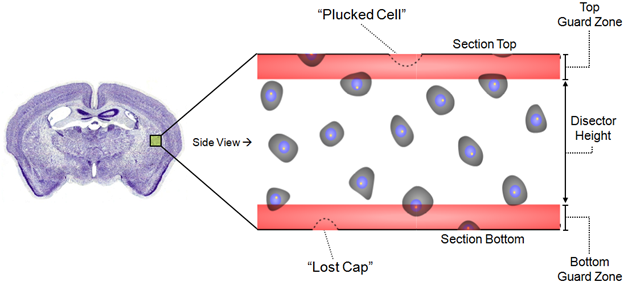Guard zones
Guard zones are regions at the top and bottom of your tissue section in which you do not mark cells. They are needed to compensate for the fact that some cells can be damaged, cut in half, or plucked from the tissue when it is cut.
The amount of damage that occurs during tissue processing varies. It is possible to empirically determine the optimal guard zone height during the parameter determination study (see Defining parameters for a pilot study). The Z histogram (see Display Probe Run List) and Resample Disector can help with the determination process.
A correctly sized guard zone will prevent over- or under-estimation.

In practice, we recommend that the guard zone be a minimum of half the thickness of the object being counted. The disector height defines the depth in which cells are counted. This also depends on how thick the tissue is.
Example: For a tissue section with a post-processing thickness of 20 microns, the top guard zone could be 4 microns, the disector height 12 microns, which will leave by default a bottom guard zone of 4 microns.
Guard zones must cover up all artifact from sectioning.
It is helpful to get a sense of how thick your tissue sections are before setting up guard zones and disector height. If the tissue is quite wavy (and therefore varies in thickness), choose a disector and guard zones that will fit into the thinnest piece of the tissue.
Disector height and upper guard zone combined should not be thinner than the thinnest measured section thickness.